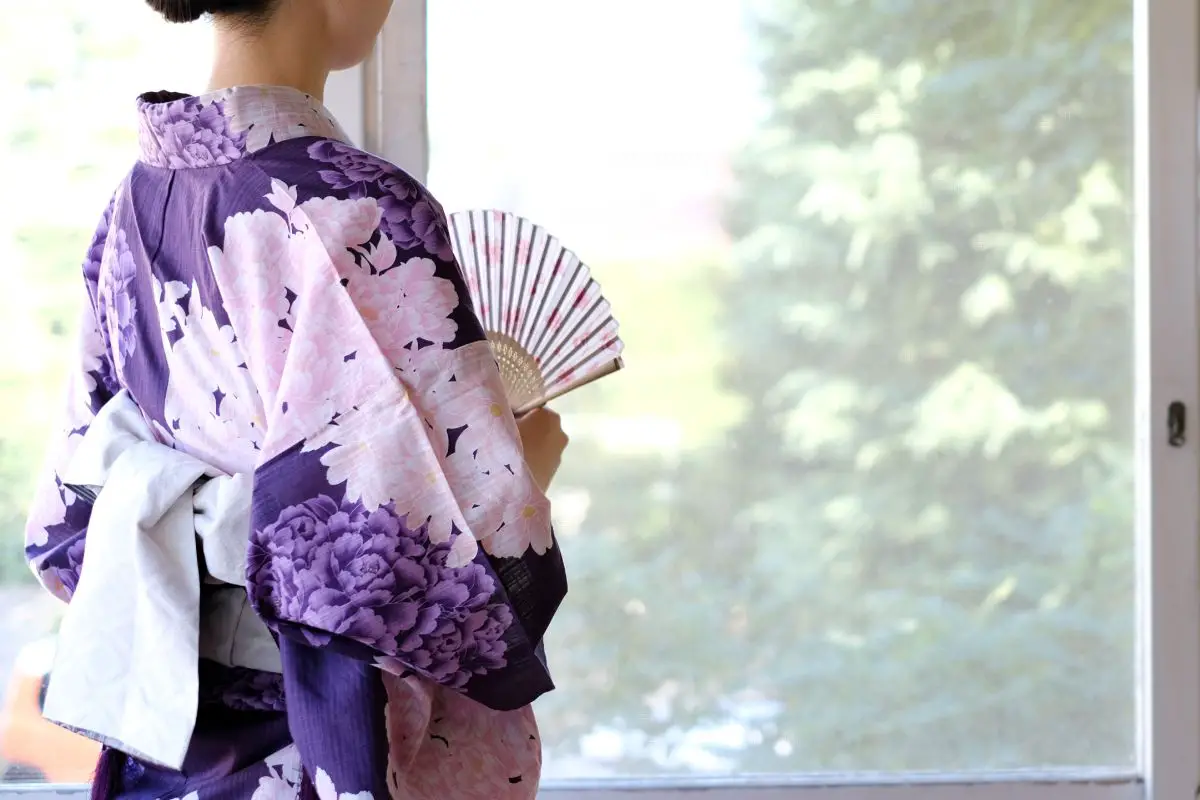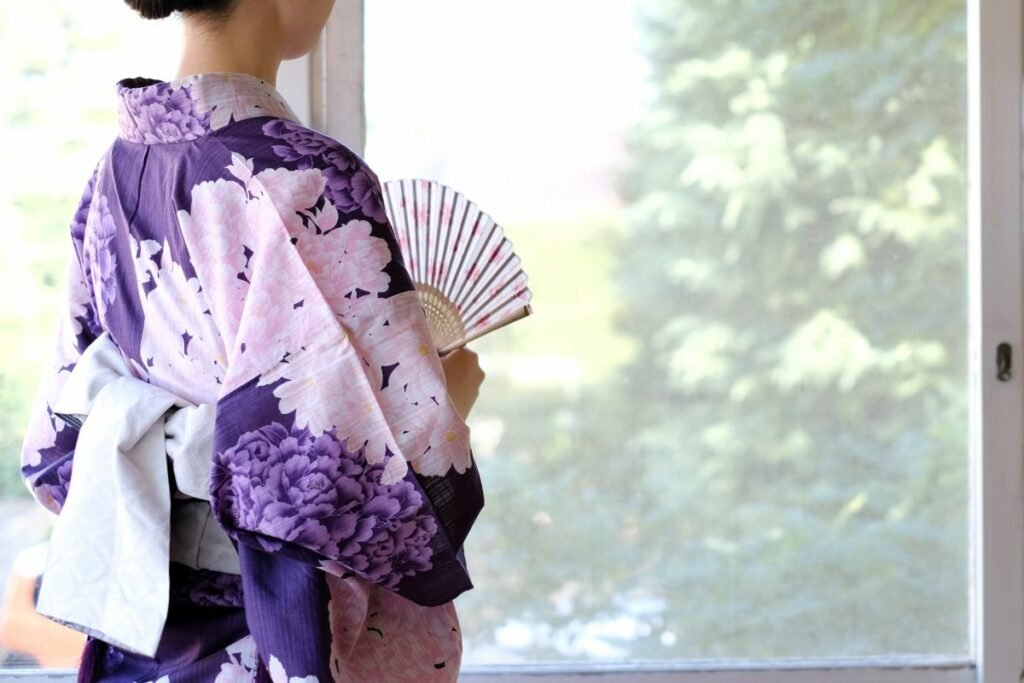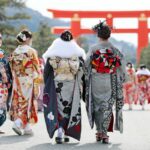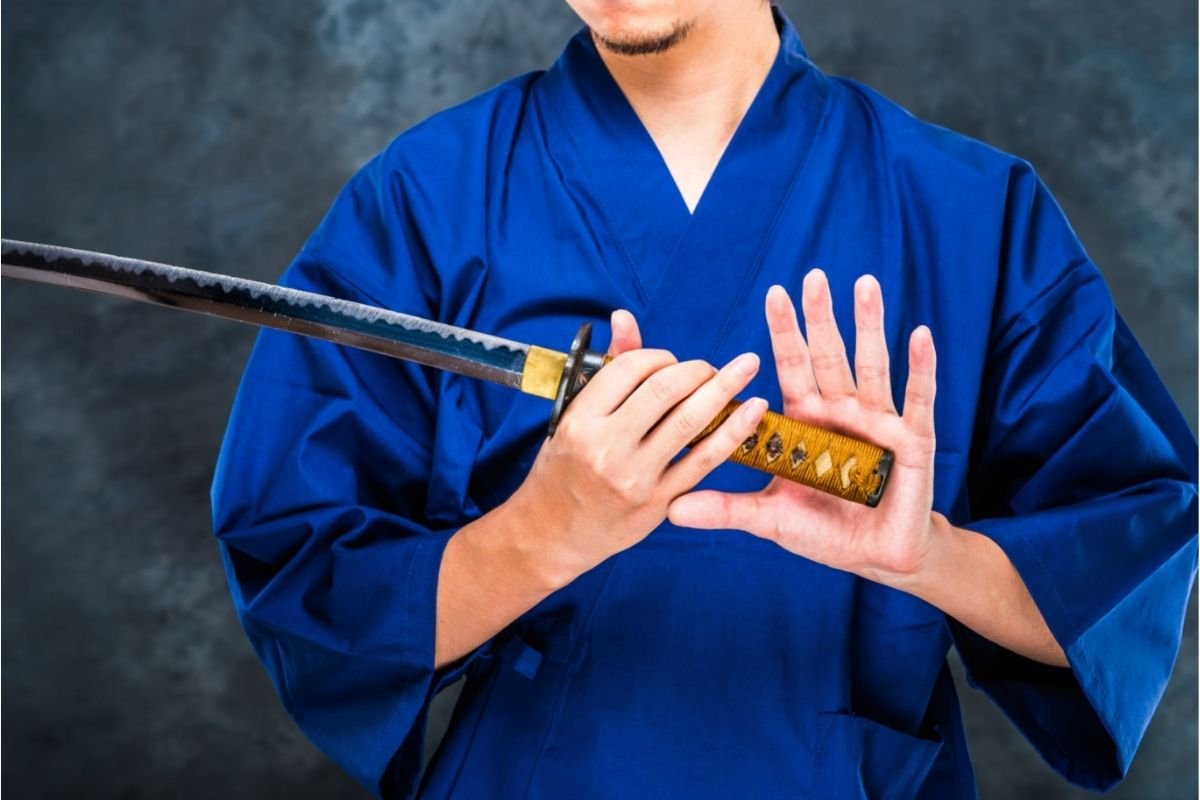The kimono is the most recognizable traditional garment in Japan. So much so that it is recognized the world over.
However, what many may not know is that “kimino” literally translates to “the thing that is worn”, and it also references many styles and can be worn on several different occasions.

Most of us are familiar with furisode, which is the most traditional variation of the kimono that is often expensive, and worn on formal occasions only.
However, there is also the yukata, which is a casual and lightweight kimono typically worn during summer festivals. Some of us are even familiar with lightweight layering kimonos that are popular in Western fashion.
Regardless, the kimono is steeped in rich history and is an integral part of Japanese life. In this article, we’re going to look at the history of the kimono, the various forms of kimono, and how they should be worn or styled (see also ‘Do Men Wear Kimonos?‘).
Let’s get started!
The History Of The Kimono
Although the kimono is considered a Japanese form of dress, it is believed that its roots originate from China.
It’s thought that the kimono was first worn during the Japanese Heian Period (794 – 1185), and was worn with the Chinese-influenced hakama. Hakama was a type of long skirt with or without separate legs (like trousers).
By the Kamakura Period (1185 – 1333) the kimono had become a part of everyday clothing, and layering was the fashion. This is when people first began to experiment with Japanese color combinations, with the colors based on gender, seasons, and even family times.
During the Muromachi period (1392-1573), it became popular to start wearing the kimono without a hakama. However, the wearer needed to find a new way to hold the robe closed, so, the obi – the wide sash around the waist – was created.
Kimono-making became a specialized craft during the Edo period (1603-1868), with some kimonos being so spectacular that they would cost more than a family home. Kimonos were kept and passed down through generations.
Although kimonos were popular for many reasons, it was largely in part to their versatility. This is because they were easy to layer and could be altered to wear during any occasion.
During autumn and winter, heavy silk kimonos were the fashion of choice, and during spring and summer a linen and cotton kimono – known as yukata – would be worn. As mentioned, the yukata is still commonly worn today in Japan during summer festivals (see also, When is Summer in Japan?‘).
Both male and female kimono fashions have rarely changed since the Edo period, however, the complexity of wearing a kimono, and the large, heavy sandals worn with it started to become an inconvenience.
During the Meiji period (1868-1912) the kimono fell out of fashion, and the government began to encourage its citizens to adopt Western clothing.
Kimonos In Today’s Society
Kimonos are inextricably linked with Japanese tradition, however, in more recent years they have become something of a cult fashion across the world.
This sudden interest in Japanese culture began around the late 1990s, and it’s easy to see what influence Japanese culture has had, specifically on the Western world.
The beautifully delicate patterns, unique silhouette, and rich, bold colors have intrigued a fashion-conscious generation. For many, the kimono offers them a chance to connect with a rediscovered culture and history.
For others, it’s a chance to wear something so breathtaking, feminine, and striking, which offers an alternative to the formal wear of Western fashion.
Even in Japan, there has been a vast increase in the number of kimono rental shops, which shows that there are a lot of people keen to rediscover this traditional and cultural garment which is usually only worn at weddings.
It’s also worth noting that there is a wave of young designers putting a fresh spin on traditional kimono styles and patterns. Even casual variations of the kimono have become wardrobe essentials.
Parts And Accessories Of The Kimono
To understand the kimono you must know about the different pieces and elements that make up the garment. Some of the main parts and are associated with the kimono are:
- Kimono: This is the main part of the garment which can be made from a variety of materials. The most common materials are cotton, linen, silk, and wool.
- Obi: This is the sash that sits on the outermost part and is tied around the kimono. There are various decorative ways that you can tie an obi.
- Koshi-himo: This is a sash that is tied around the waist to hold the kimono in place.
- Datejime: This is a belt that is tied over the kimono but under the obi. It helps the obi to keep its shape.
- Juban: This is an undergarment that is worn exclusively with the kimono.
- Geta/Zori: Traditional types of footwear worn with the kimono (look very similar to modern sandals/flip-flops).
Tabi: Socks designed to be worn with Japanese footwear. The toe area is split into two separate sections to accommodate the geta/zori.
Different Types Of Kimono
As we have already noted, there are a few different variations of the kimono. Some are more traditional and formal, and others are more casual and considered everyday wear. Some different variations of kimono are:
Furisode
The furisode is a type of kimono worn by young, unmarried women in Japanese culture. The furisode is most recognizable for its long sleeves and bright colors and patterns. It is traditionally worn on Coming of Age Day, otherwise known as Seijin no Hi in Japan.
Tomesode
This is another formal kimono worn by women who are married. These are also typically bright-colored kimonos, however, below the waist there are usually intricate patterns.
Although they can be brightly colored, traditionally, black tomesodes are worn by mothers attending their child’s wedding.
Yukata
Yukata are typically worn during summer festivals in Japan and are made from a thin material. They can be worn by both male and female wearers and are typically noted as not as bright or detailed as formal kimonos.
Houmongi
Houmongi translates to “visiting kimono” and can be worn by any age or marital status. These kimonos tend to have patterns across the shoulders and the bottom and are usually worn to weddings or tea ceremonies.
Iromuji
These are plain, solid-colored kimonos that can be worn by both married and unmarried women. These kimonos can be any color – except for white or black – but they tend to come in more subdued tones.
Crests can be added to iromuji kimonos, however, the more crests the more formal the garment becomes. Overall, this is a simple kimono.
Komon
The komon is another type of casual kimono, similar to the yukata. They usually have a repeated pattern and are considered the perfect casual, everyday wear. Before Western clothing became the norm, the komon was considered everyday wear in Japan.
How To Wear A Kimono
It can be pretty daunting having to put on a kimono, but you’re not alone. Here are some tips on how to wear the Japanese kimono correctly.
First and foremost you want to put the juban (undergarment) and the tabi on – only put the tabi on if you plan to wear traditional japanese shoes.
Next, make sure that you center the back seam of the kimono along your spine and begin to wrap the kimono around your body.
It’s important that you wrap the right side of your kimono towards the left first, and then wrap the left tightly towards the right side of your body. With kimonos, it’s always leftover right (on top).
After the kimono is wrapped, tie the koshi-himo sash directly in front after crossing around the back. There should be some excess fabric above where you have tied the koshi-himo so you want to flatten this fabric over the sash.
Next, wrap the datejime around your waist and tie it at the front. You can also get velcro datejime which makes this step easier.
After these steps, it’s time for the obi. This needs to be wrapped around your waist and folded in whichever way you wish to knot it.
As mentioned there are several different decorative ways that you can tie an obi, but once knotted you need to slide the knotted part towards the back. You can also get pre-made bows which make attaching an obi a lot simpler.
You also have the option to further accessorize the obi if you wish. For instance, you can add a decorative cord which is known as obi-jime or an obi-age sash.
Finally, it’s time to put on the geta. These can range from casual to formal depending on the type of kimono you’re wearing and the social event you’re attending.
Traditionally hair is worn up and away from the face.
The ‘Fashion’ Kimono
In the last few decades, there has been a massive surge of interest in Japanese culture in Western society, particularly in anime, film, cuisine, home interior, and fashion.
In regards to fashion, there has been a heightened interest in Tokyo street style, anime cosplay or anime-related styles and trends, and traditional Japanese garments and fashions.
The kimono is one such element of Japanese fashion that the Western world has adopted in everyday style. However, the ‘fashion’ kimono is way more casual in comparison to even the more casual Japanese variations of the kimono.
In Western fashion, the kimono is a lightweight, open garment that has flowy sleeves. Most kimonos have a bold, bright pattern, and can be styled both casually or dressy.
How To Style A ‘Fashion’ Kimono
Kimonos typically work best for summer-inspired outfits, largely in part to their loose style and lightweight material. Here are a few different ways that you can style your kimono in summer.
Casual Jeans Look
There are a few different ways that you can style your kimono with jeans. Most people opt to pair their kimono with a pair of skinny jeans, a plain tank top, and platform boots. For a more relaxed vibe, try switching out your skinny jeans for a pair of mom jeans and some chic mules.
Boho Chic
Kimonos – specifically long, brightly patterned kimonos – are perfect for achieving that effortless boho look (see also, ‘What is Amigurumi?‘).
Try wearing your kimono with a plain tank, bell bottom jeans, platform boots or mules, and a wide brim hat. Don’t forget to layer on your necklaces, rings, and bracelets for that ultimate bohemian vibe.
You can also switch out the bell bottom jeans for shorts or a skirt, and feel free to experiment with the shoes of your choice – even cowboy boots will work.
The Kimono Dress
If you want to give your kimono a more structured look, belt your kimono around your waist so it has the appearance of a flared dress. Chuck on your favorite pair of boots and accessories for that effortlessly chic vibe.
A Summer’s Day
Kimonos are so lightweight that you can easily throw one on top of your favorite tank top and shorts on a particularly hot day. Thanks to the loose-flowing fabric you can count on your kimono to keep you cool.
Beach Cover Up
Kimonos are the perfect accessory to bring with you for a day at the beach. It’s so easy to put one over your favorite bikini or one-piece and is perfect for when it starts getting chillier in the evening.
Thanks to the bold, summery patterns, they’re perfect for giving you that beach chic vibe.
Final Thoughts
So there you have it, the long and decorated history of the Japanese kimono and how it has influenced Western fashion.
As traditional Japanese kimonos have made a resurgence both in Japan and the West, it’s allowed a whole new generation to appreciate and learn about the beauty of the kimono.
If you want to wear a traditional Japanese kimono it’s important that you wear it correctly, and respect the history and culture that the kimono represents.
However, if you’re looking to wear the Western, casual kimono, feel free to experiment with different styles and variations.









